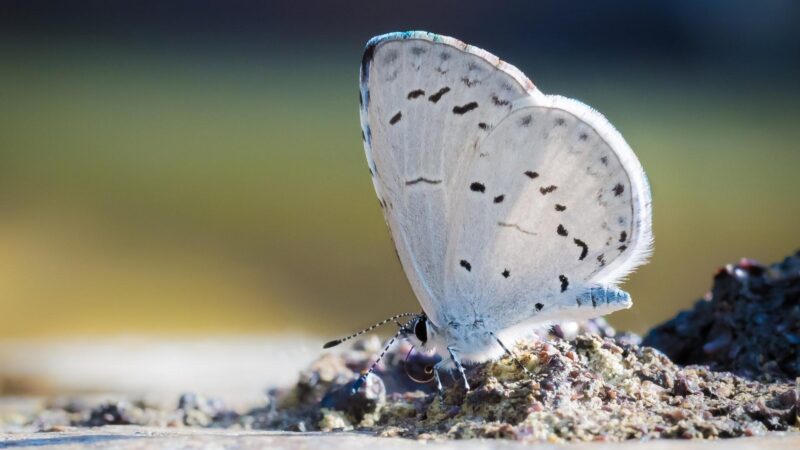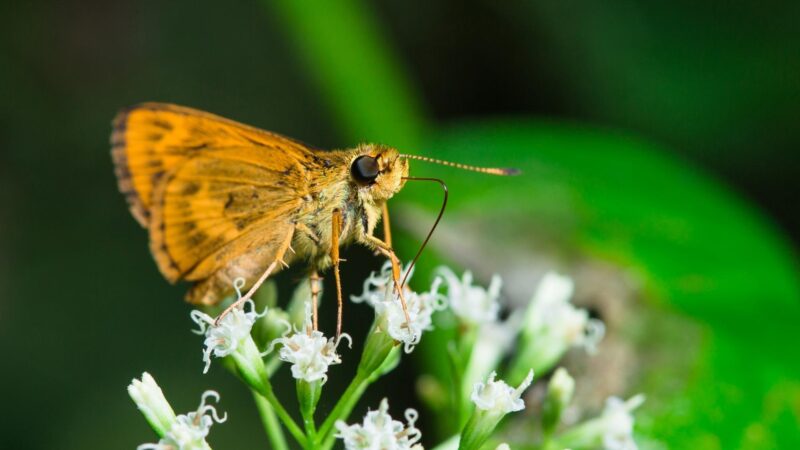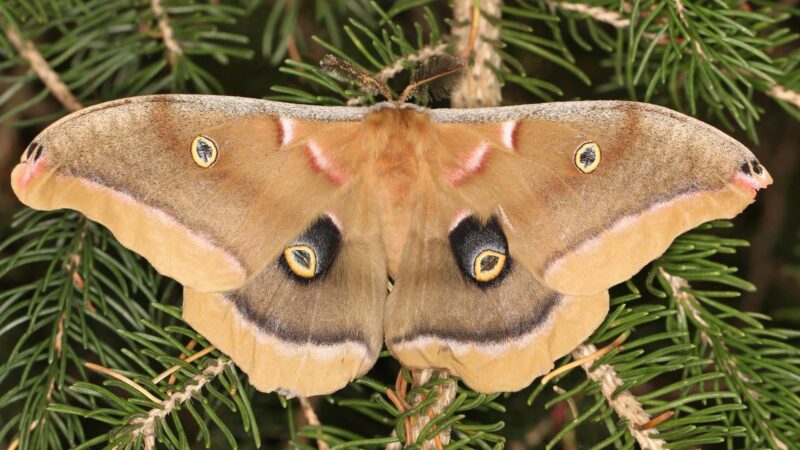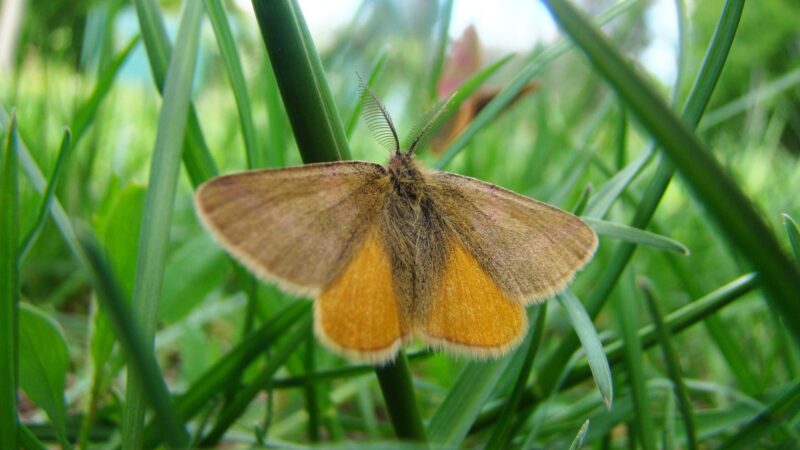The zigzag flight patterns are some of the signs that you have moths on your lawn. You would usually see them on turfgrass at dusk and not cause damage.
But wait until you see the brown patches that are the size of a baseball. They are the feeding damage of moth larvae. The patches are not easily detected when drought takes place in July and August.
How to get rid of moths on your lawn? From mid-October until mid-April, use horticultural oil labeled for moths to kill their egg masses. From May to June, you have to use either chemical or biological pesticides to eradicate caterpillars. If there are only a few of them, you can collect and get rid of them through soapy water.
Therefore, it’s best to get rid of moths that are still in their early life stages. The moth larvae can cause more damage. Besides chewing on plants’ stems and leaves, they can make the patches bigger as they get near maturity.
The damages caused by moth larvae can sometimes be mistaken for the effects of dog urine. To evaluate situations correctly, learn more about moths and what they do on your lawn.
Why Are There Moths All Over My Lawn?
If you’re distressed about moths all over your lawn, you’re not alone. This is a common occurrence all over the US. There’s an occasional population explosion of insects in different states, and wasps are one of them.
The exact reason can’t be pinpointed, but it has something to do with environmental conditions and weather. But know that extended wet weather encourages moth growth and the plants that they consume.
What are the White Moths in My Lawn?

The white moths are also called lawn moths. It can grow up to ¾ inch with an appendage that appears like a snout, but some may be bigger. You will see them with wings folded closely when at rest, so they appear with a slim body.
The female lawn moth can lay dozens of eggs on the grass blades once or more a year. Thus, the birth of many generations occurs simultaneously.
It takes a week or two for the larvae to leave the eggs. To reach maturity, they feed on the foliage of their grass host for several weeks. Hence, there are irregular patches.
The larvae can attack any grass lawn or turf, and it makes grasses turn brown and decay quickly when there’s drought.
What Are the Brown Moths in My Yard?

The brown moths are also called grass moths. They usually dwell on turfgrass. The sight of swarming brown moths doesn’t only worry turfgrass managers but farmers as well. They’re minor pests that feed on varieties of plants, weeds, and flowers.
Grass moths can be everywhere, but people mostly notice them in grassy areas where they would usually walk. The larvae of these moths are called webworms. They stay in damp areas and shrubbery during the day.
When evening comes, they become active. It eats grass stems and blades that are close to the ground after sunset throughout the night and until dusk.
Due to their feeding habits, small-sized patches appear and the grass turns yellow-brown in the middle of the summer. However, well-maintained turfgrass can’t give in to these effects.
Do Lawn Moths Bite?

Lawn moths don’t bite as these insects are capable of doing it. They don’t sting as well.
What Do Grass Moths Eat?

Grass moths eat flower nectar and dew that sit on grass blades.
Related: What Do Moths Eat? | All You Need to Know!
Are Moths Bad For Lawns?
Adult moths don’t destroy lawns as their activities include sipping dew from grasses and flowers’ nectar. It’s only their larvae that feed on grass or plants.
Do Moths Kill Grass?
Moths don’t kill grass because they only consume the leaves. Although the grass turns brown because of the larvae’s appetite, there is no root damage. The appearance only gets worse when there’s drought and heavy traffic.
Moths don’t cause significant damage on grass lawns or turf as the grasses can survive. Severe damage rarely happens when the second generation of larvae strikes the grass.
Do Moths Lay Eggs in the Grass?
The moth lays eggs on grass blades.
What Will Kill Lawn Moths?
Insecticides with reliable formulations can kill lawn moths. The best time to use them is in the early evening as this is the period that they become active.
Bayer Advanced Complete Insect Killer for Soil and Turf
This is a ready-to-use spray since it dilutes instantly. It has imidacloprid and ß-cyfuthrin to control above-ground pests. A granule version of this product is also available. It’s ready to use, and for every 1,000 square feet, 2 or 3 pounds are needed.
Spectracide Triazicide Insect Killer for Lawns and Landscapes Concentrate
With gamma-cyhalothrin, it can control surface insects efficiently. Before application, don’t water or mow the lawn before administering this insecticide. Three tablespoons of this should be mixed with water for 240 square feet of lawn.
- OUTDOOR USE: Protects lawns, vegetables, fruit and nut trees,...
- KILLS 260+ INSECTS BY CONTACT: Kills above and below ground –...
- NON-STAINING: Non-staining to most home siding depending on age...
- CONCENTRATE FORMULA: Mix with water at the rates listed on the...
Monterey Garden Insect Spray
To make an effective spray, a gallon of water should have 2 oz of this formula. Also, water or mow the lawn after spraying. A thousand square feet needs 3 gallons of this insect spray mixture.
- Fast acting and odorless - Monterey insect Killer is a bacterial...
- Controls many insects - the insect treatment Spray controls...
- Variety of uses - this pest control can be used on outdoor...
- Easy spray application - this CSI alternative product may be...
- Organic gardening - the active ingredient in our bug Killer spray...
GrubEx1
The ideal time for the application of this insecticide is from spring to late summer. Dry the lawn first with a spreader, and after application, water it lightly.
- Scotts GrubEx1 Season Long Grub Killer can help prevent turf...
- One application of this lawn care treatment kills and prevents...
- This grub killer also controls caterpillars (armyworm),...
- Apply this granular insecticide to a dry lawn in the spring or...
- One 28.7 lb. bag of Scotts GrubEx1 Season Long Grub Killer covers...
These are ready-to-use granules that can deliver results overnight.
No products found.
How Do I Get Rid of Lawn Moths Naturally?
Since the larvae of lawn moths are the culprit of the damage, you can depend on birds to manage their population. But taking action ensures that you reach the goal of getting rid of them through the following ways:
Soap Flush Technique
If you can see early signs of larvae attacking your lawn, you can have the ‘soap flush technique’ by mixing an ounce of dishwashing soap with a gallon of water. This amount is enough for one square yard.
You can look for the larvae by filling a can with a bottom buried in the turf. Fill it with a mixture of water and dishwashing liquid. The mixture irritates insects, so you can see them float on the mixture. Don’t touch the can and let them perish in the soapy water.
Horticultural Oil
Another way to get rid of lawn months naturally is through horticultural oil. You can spray it on the grass. Never use mineral oil, motor oil, and other non-horticultural oil. A non-chemical curative that you can utilize is the insect-parasitic nematodes.
Insect-Parasitic Nematodes
Steinernema spp proves to be effective in reducing larvae population from 44% to 91% since temperature depends on the rate of applied nematodes and temperature. Keep in mind that insect-parasitic nematodes have a short shelf life.
You’ll know what to do as long as you read the label instructions. Don’t forget that irrigating these organisms is crucial.
Handle them with care as they’re living creatures too. Check the expiry date of the package before you proceed with the application. There are many species of nematodes, but the most recommended is Bacillus thuringiensis.
Resistant Grass Cultivar
Planting resistant grass cultivars is another natural method of getting rid of lawn moths. You can look for Amerishade, Captiva, Florentine, and Winchester. Refrain from over-fertilizing your grass.
It can stimulate growth enhancement and thatch accumulation which encourage the attacks of moth larvae.
Light Citronella Candles
Moths will naturally avoid your outdoor spaces by avoiding the fragrance of burning citronella or heated citronella oil. To help scare off moths, use these citronella candles.
Additionally, you can apply citronella oil onto areas that moths could find attractive. While your lights are out, think about putting some citronella on them. Once they are turned on, the oil will be heated and the moth-repellent aroma will begin to spread.
Moth Repellent Plants
Many popular garden plants are effective at warding off dangerous moths. Lavender, rosemary, and thyme are unpleasant scents to moths. Any of these plants you have in your yard can assist to lower the number of moths in the area by keeping them away. Additionally, these plants give healthy herbs that you may use in cooking.
Vinegar
On touch, moths and live larvae are killed by vinegar. Either either pour vinegar into a spray bottle or dilute it with as much as a cup of water then spray directly on the moth infestation.
Large infestations, however, do not respond well to this remedy. To kill moths, you must spray them directly. Since vinegar may damage grass and plants upon touch, you cannot use it to cure a whole outdoor area. Although vinegar works well to destroy individual moths, a large-scale moth infestation cannot be resolved with vinegar.
List of Sources
Management guide for homeowners. University of Winconsin-Madison.
Gibb, T., Obermeyer, J. Grass Moths Everywhere. Purdue University.
Hale, F. A., Vail, K. M. (2020). Lawn Insects: How to Control Them? University of Tennessee.
Lawn moths and sod webworms. University of California Agriculture & Natural Resources.
Sod Webworms. University of Georgia Extension.
- Bed Bug Surge 2025: How to Detect, Prevent, and Safely Eliminate Infestations in Top U.S. Cities - June 18, 2025
- Asian Needle Ants Invade US Homes: 2025 Guide to Identification, Risks, and Effective Control - June 11, 2025
- New World Screwworm Alert: How US Livestock Owners Can Prevent Outbreaks and Protect Herds [Summer 2025 Update] - June 8, 2025




